Learn from your favourite guitar players here.
Related Tags
How to get better at guitar using the CAGED system (Part 2)
For our second part of his exploration of the CAGED system and how it can help you, David Henriksson asks you to dig a little deeper into those tried and tested pentatonic boxes.

Image: Getty Images
Pentatonic scales are among the first tools most guitarists learn early on when they want to learn how to play a solo. A lot of amazing music has been made using pentatonic scales and a lot of us love them, but I feel like a lot of players just learn the shapes but never really understand how the scales work or how they’re connected to the chord progression.
It’s common to name the pentatonic boxes by numbers (A minor pentatonic box 1 for example) but in many ways it makes more sense to learn them based around the chord shapes they are connected to, as we wanna know how the underlying harmony and the scale connects.
The CAGED System is based around five basic chord shapes, these chords are all triads which means they consist of three different notes. The pentatonic scales consist of five notes (penta means five in ancient Greek) which means we’ll have to add two more notes in each octave to these triad shapes to find our pentatonic scales. We’ll start with the major pentatonic scale, but first it’s important that we understand how this scale is constructed. The C major scale consists of the following seven notes: C, D, E, F, G, A, B. This is, essentially, a sequence of whole steps and half steps (steps are also sometimes called ‘tones’ and the terms can be used interchangeably, while a ‘half tone’ is also called a ‘semitone’).
A whole step is the distance between two notes that have one note in between them. A half step is the distance between two notes that are right next to each other, with no another note in between. The first fret of the B string on a six-string guitar in standard tuning is a C note, if we skip the second fret and play the third fret, we’ll have the note D – this is the distance of a whole step. If go back to the C note on the first fret and then go the other way, down one fret to the open string, we have a B note – this is the distance of a half step.
The sequence of whole steps and half steps in the major scale is:
C D E F G A B C
Whole Whole Half Whole Whole Whole Half
So that means we have half steps from the 3rd to 4th note of the scale and the 7th note back to the root note we started on, only now the root note is one octave higher. Try to play this sequence of notes from all of the open strings on your guitar. This should sound quite familiar as most of the harmony and melody in western music derives from this scale.
But now, let’s go back to the major pentatonic, this scale leaves out the fourth and the seventh degree of the full major scale. This means, in the key of C, that instead of a whole step between E and F and a whole step between F and G we now have a step and a half between E and G. The same thing happens when we leave out the B note and instead end up with a step and a half between A and C. This means, there are no half steps in a major pentatonic scale. I’ll get back to the pros and cons of this later.
Now grab your guitar because it’s time to play. If you’ve worked on the material from first part of this lesson series, you should have the triad shapes down already. Now let’s add the second and sixth degree from the major scale to each major triad.


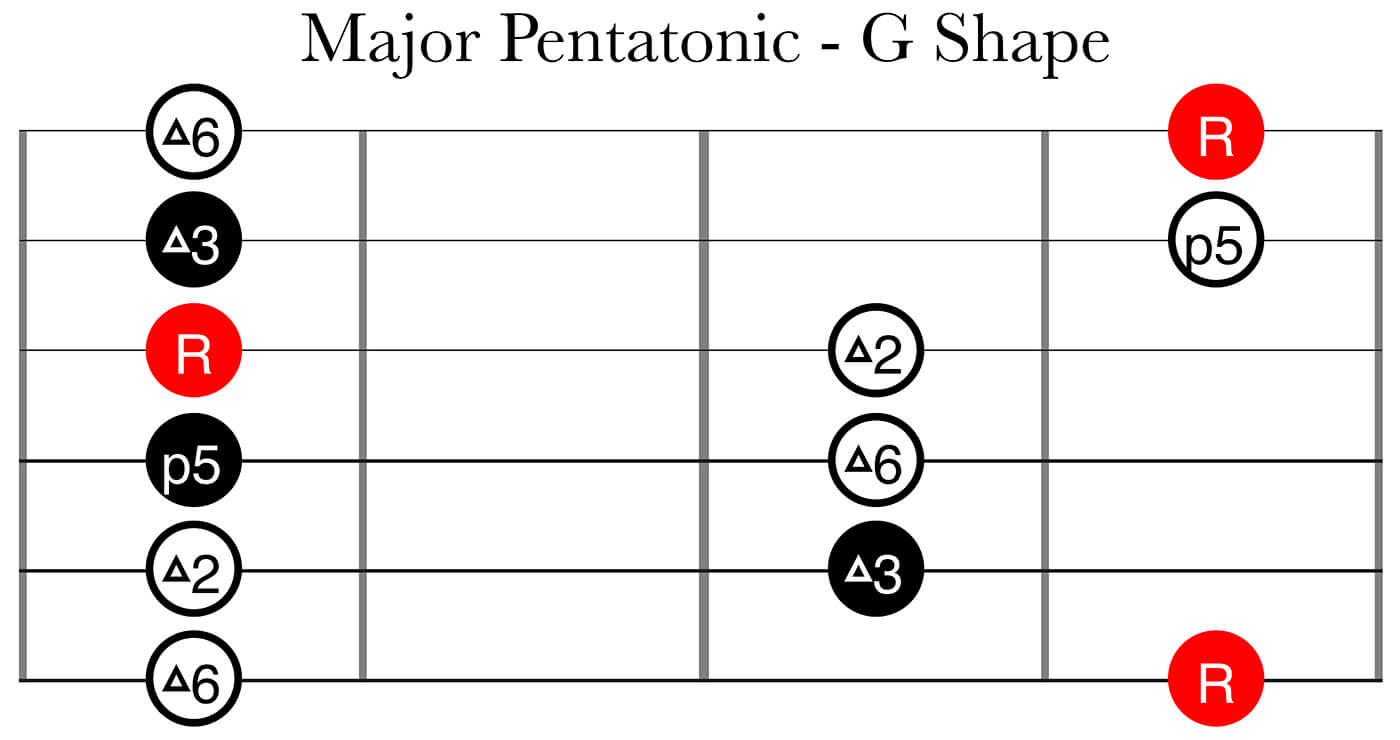


In these diagrams the notes from our core chord shapes are solid (the root notes are red) and the notes we add for the full major pentatonic shapes are hollow. I’ve also marked all the intervals so you can see where all the major 2nds are for example. The triangles mean major 2nd, major 3rd and major 6th while the p5 refers to a perfect 5th (all intervals are taken from the major scale). We will get more in-depth with intervals in the next part of this lesson series.
I want you to start seeing the similarities between these scale shapes by separating adjacent string pairs in each shape. For example, the fingering of the root, 2nd, 3rd and 5th is the same on the A and D strings in the A shape as it is on the low E and A strings in the E shape as well as on the D and G strings in the D shape AND on the B and high E strings in the C shape. We can’t find that fingering in the G shape however, since the tuning interval between the B and G string is a major 3rd rather than a perfect 4th as between the all the other string pairs. Working on this, you’ll start seeing repeating patterns that’ll make it easier to memorize AND use these scale shapes in a musical setting.
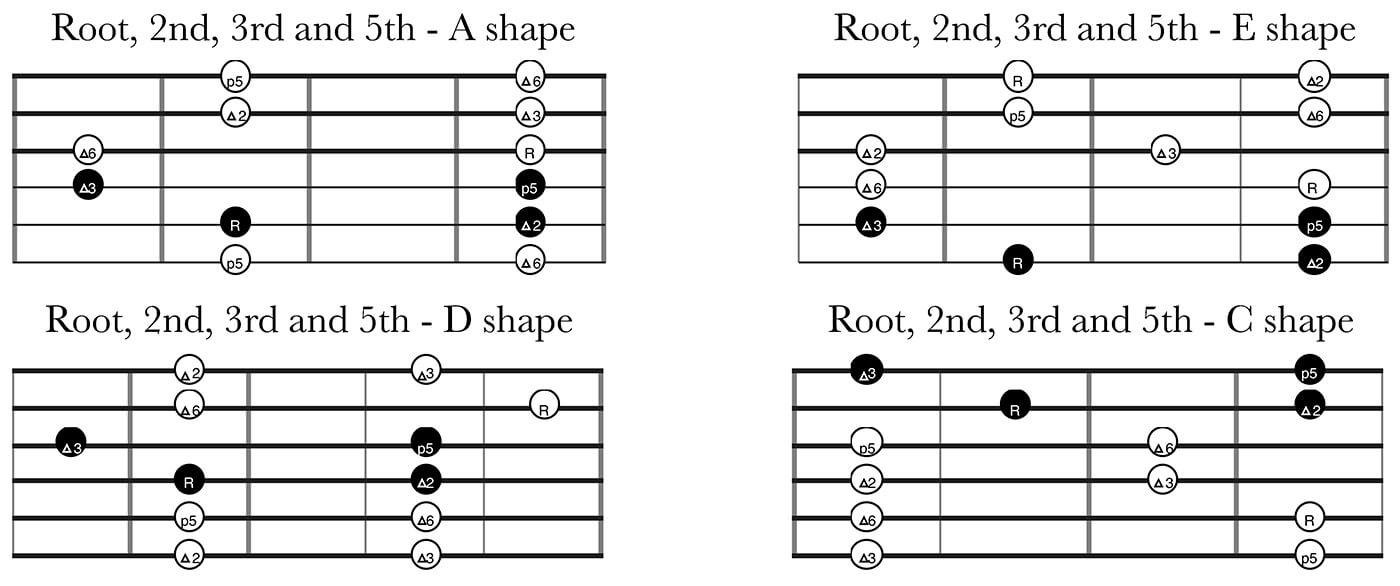
Now I encourage you to come up with a three or four-note phrase played on two adjacent strings and then find it with the same fingering in all the major pentatonic shapes. Well, except for one that probably won’t work. Figure out which one it is in the case of your particular lick!
Let’s go minor
Now let’s move on to the minor pentatonic. Quite a few of you might already know these scale shapes or ‘boxes’ as they’re commonly referred to – but bear with me. If you read these following paragraphs, I can hopefully get you to understand the minor pentatonic on a deeper level.
As the major pentatonic is derived from the major scale the minor pentatonic is a stripped down natural minor scale. Instead of doing this from the key of Am, which is quite common, I’m gonna stick with C as the root. The C natural minor scale consists of the following seven notes: C, D, E♭, F, G, A♭, B♭.
The sequence of whole steps and half steps in the C natural minor scale is:
C D Eb F G Ab Bb C
Whole Half Whole Whole Half Whole Whole
So that means we now have the half steps between the 2nd to 3rd note of the scale as well as between the 5th and 6th note. Again, try playing this sequence of notes from all of the open strings on your guitar.
When playing the minor pentatonic we remove the 2nd and 6th degree of the natural minor scale, creating a larger interval of a step and a half between the root and the minor 3rd (C to E♭) as well as between the 5th and flat/minor 7th (G to B♭). As with the major pentatonic, there are no half steps in the minor pentatonic. This makes these scales more harmonically ‘safe’ when improvising for example, but at the same time less colourful and exciting since they in most cases don’t contain enough notes to outline the underlying chord progression. However, pentatonic scales are still super cool sounding and useful – I just want you to be aware of the limitations of a five-note scale without any half steps. Anyway, here are the fingerings:
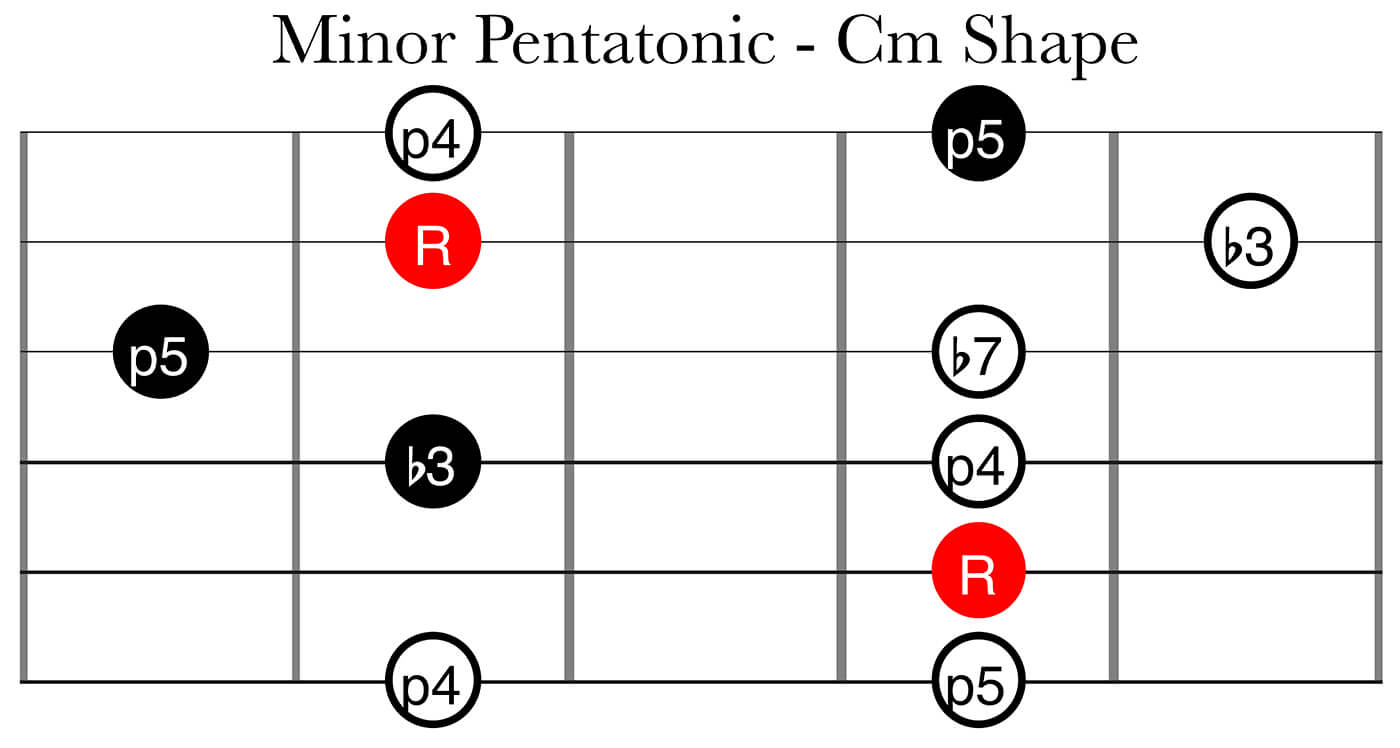



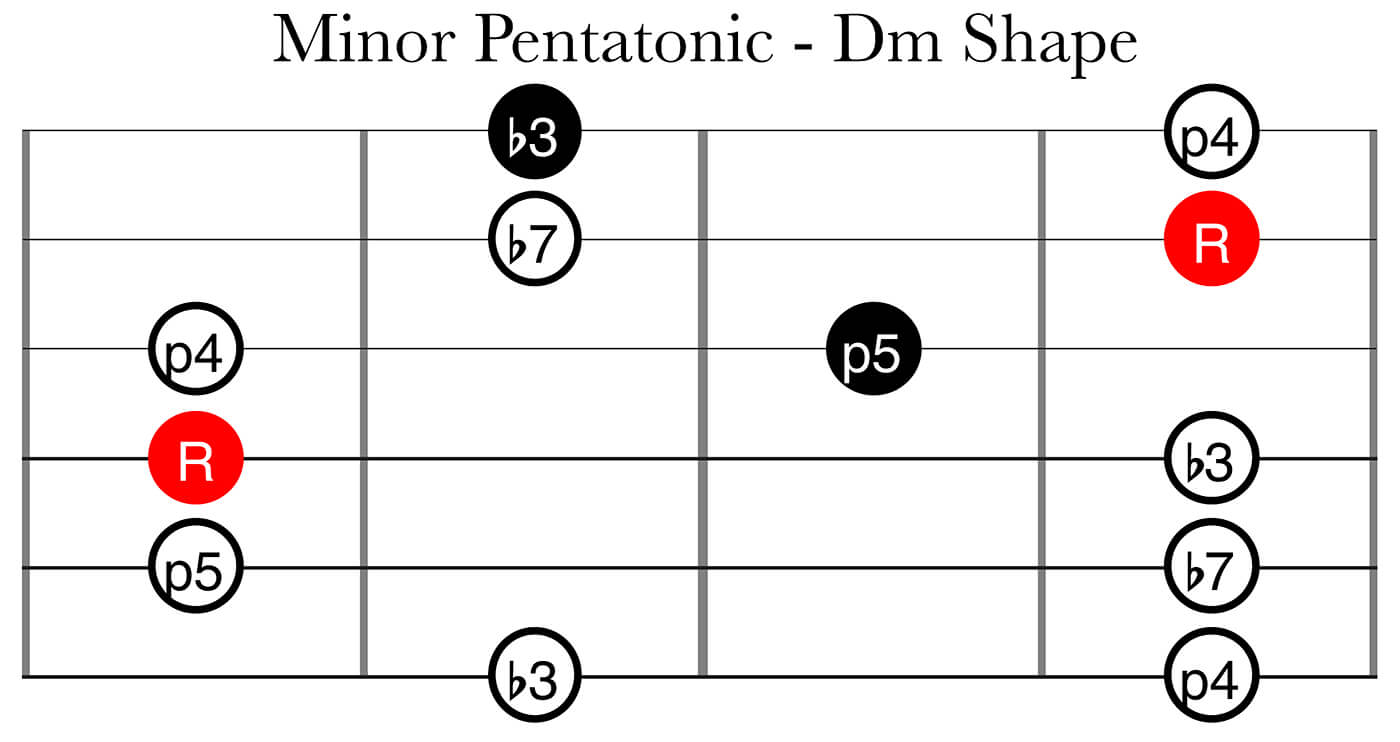
Similarities and differences
Both of these scales feature the root and the 5th, but the rest of the tonal material differs between the two scales. If we look at it like this, you might find something that you can use to easier navigate between major and minor as well as different positions and keys:
- C major pentatonic: C D E G A
R M2 M3 5 M6
- C minor pentatonic: C E♭ F G B♭
R m3 4 5 m7
Since we know that the root and 5th (C and G respectively) are present in both scales, let’s check out the relationship between the other three notes. As you can see above the second note of the C major pentatonic (D) is a half-step below the second note of the C minor pentatonic (E♭). The same goes for the third note of these scales, the E of the major pentatonic is a half-step below the F of the minor pentatonic. And, you may suspect a pattern by now, the same goes for the last note of these scales – A being a half step below Bb. In the following example there’s first a minor pentatonic phrase, then the E♭, B♭ and F are flattened a half step each which gives us a similar lick but now with a major feel to it.
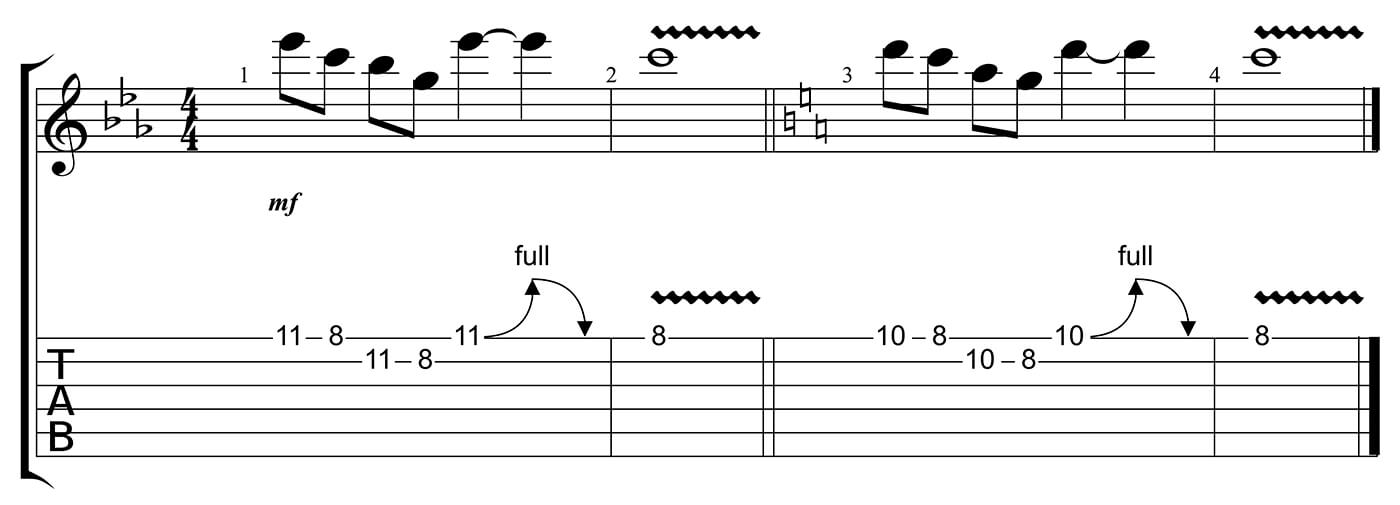
Now, try changing the tonality of some of your own minor pentatonic licks into major using the same approach. Also try it the other way around, turning major ideas into minor.
The ones of you that have been using the pentatonic scales in the past might be used to calling the fingerings ‘Box 1’, ‘Box 2’ and so on. For example, the C minor pentatonic box 1 has the root note on the 8th fret of the low E string – this would be what we call the ‘minor pentatonic Em shape’ when referring to the CAGED System.

As long as we stick with minor, people seem to agree to call that ‘Box 1’. However, when I quickly Googled ‘major pentatonic box patterns’ I found a few contradictory results. Some people call the ‘major pentatonic G Shape’ Box 1 and others call the ‘major pentatonic E Shape’ Box 1. This could of course be confusing when trying to communicate with others or when learning how to navigate the fretboard. In my opinion, the obvious benefit of naming the positions with the CAGED system is that you’ll connect the scale to the chord that it’s based around and harmonically connected to.
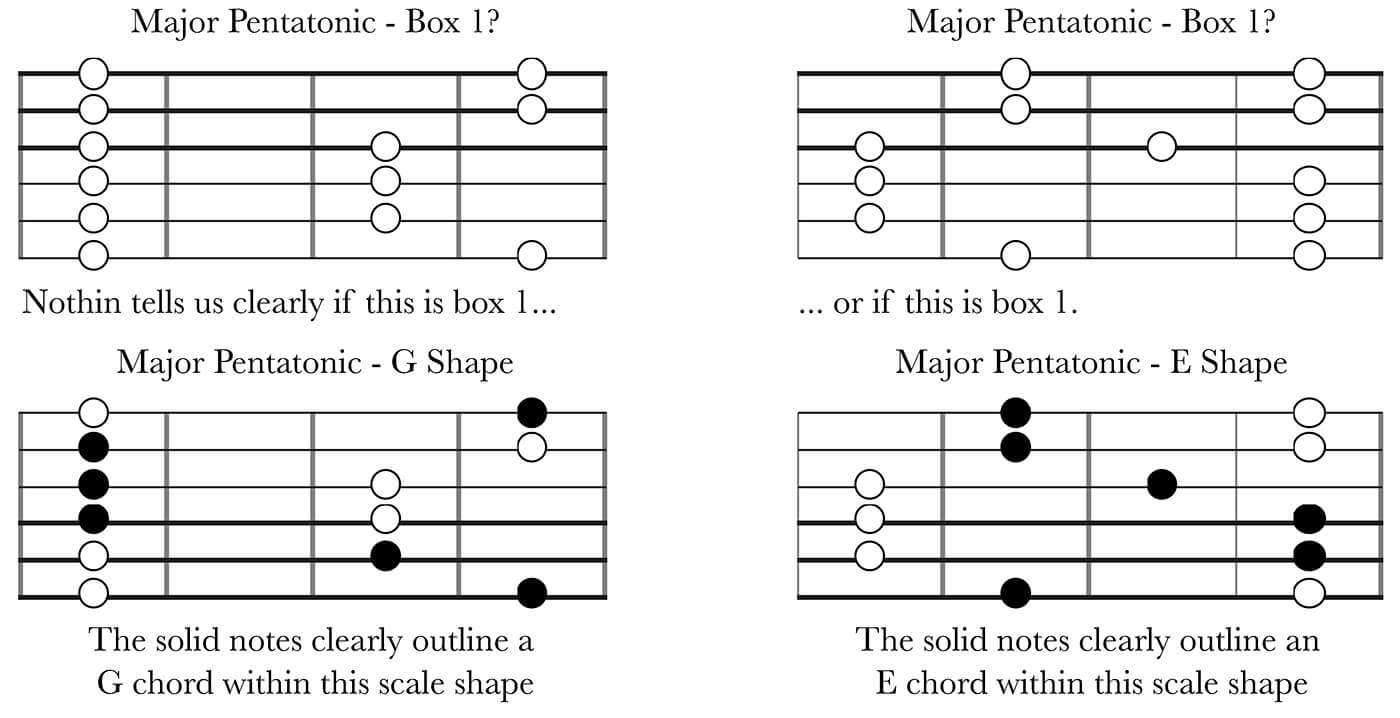
So, the minor pentatonic Em Shape and the major pentatonic G shape is the same fingering. Our fingers can benefit from that in the way that we don’t have to learn two different fingerings, BUT our ears and musical awareness have to recognize that they are NOT the same scales or the same intervals – since they have different root notes and therefore different scale formulas. Again, that’s a reason to visualize and learn these scales around the CAGED shapes. After all, you’ll probably be playing your scales over some kind of chord progression, right?
